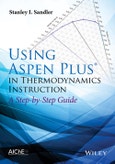A step-by-step guide for students (and faculty) on the use of Aspen in teaching thermodynamics
- Easily-accessible modern computational techniques opening up new vistas in teaching thermodynamics
A range of applications of Aspen Plus in the prediction and calculation of thermodynamic properties and phase behavior using the state-of-the art methods
- Encourages students to develop engineering insight by doing repetitive calculations with changes in parameters and/or models
- Calculations and application examples in a step-by-step manner designed for out-of-classroom self-study
- Makes it possible to easily integrate Aspen Plus into thermodynamics courses without using in-class time
- Stresses the application of thermodynamics to real problems
Table of Contents
Preface vii
An Introduction for Students ix
1. Getting Started with Aspen Plus® 1
Problems 9
2. Two Simple Simulations 10
Problems 34
3. Pure Component Property Analysis 36
Problems 55
4. The NIST ThermoData Engine (TDE) 56
Problems 64
5. Vapor–Liquid Equilibrium Calculations Using Activity Coefficient Models 66
5.1 Property Analysis Method 69
5.2 The Simulation Method 80
5.3 Regression of Binary VLE Data with Activity Coefficient Models 89
Problems 115
6. Vapor–Liquid Equilibrium Calculations Using an Equation of State 119
6.1 The Property Analysis Method 120
6.2 The Simulation Method 122
6.3 Regression of Binary VLE Data with an Equation of State 129
Problems 142
7. Regression of Liquid–Liquid Equilibrium (LLE) Data and Vapor–Liquid–Liquid Equilibrium (VLLE) and Predictions 144
7.1 Liquid–Liquid Data Regression 144
7.2 The Prediction of Liquid–Liquid and Vapor–Liquid–Liquid Equilibrium 158
7.3 High Pressure Vapor–Liquid–Liquid Equilibrium 167
Problems 173
8. The Property Methods Assistant and Property Estimation 175
8.1 The Property Methods Assistant 175
8.2 Property Estimation 182
8.3 Regressing Infinite Dilution Activity Coefficient Data 188
Problems 201
9. Chemical Reaction Equilibrium in Aspen Plus® 203
Problems 229
10. Shortcut Distillation Calculations 233
Problems 250
11. A Rigorous Distillation Calculation: RadFrac 252
Problems 271
12. Liquid–Liquid Extraction 272
Problems 286
13. Sensitivity Analysis: A Tool for Repetitive Calculations 287
Problems 304
14. Electrolyte Solutions 305
Problems 337
Index 339








